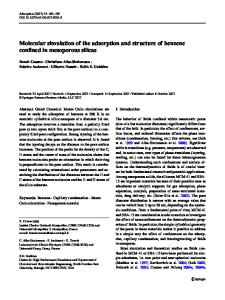Accessibility and strength of H-acceptor hydroxyls of ordered mesoporous silicas probed by pyridine donor
- PDF / 1,354,214 Bytes
- 13 Pages / 595.276 x 790.866 pts Page_size
- 67 Downloads / 225 Views
Accessibility and strength of H‑acceptor hydroxyls of ordered mesoporous silicas probed by pyridine donor Mayara R. Alves1 · Mateus F. Paiva1 · Pablo T. A. Campos1 · Elon F. de Freitas1 · Maria Clara H. Clemente1 · Gesley Alex V. Martins1 · Alceu T. Silveira Jr.2 · Luis C. Cides da Silva3 · Marcia C. A. Fantini3 · Sílvia C. L. Dias1 · José A. Dias1 Accepted: 7 October 2020 © Springer Science+Business Media, LLC, part of Springer Nature 2020
Abstract Ordered mesoporous silica (OMS) is an important and useful material for a variety of applications, including catalysis, adsorption, sensing and controlled drug delivery. The surface chemistry and the silanol groups on OMS pores are key properties for the potential modification and application of this material. This research aimed to synthesize (using standard protocols) and differentiate the accessibility and strength of the H-acceptor Si–OH from FDU-12, SBA-16, MCM-41 and SBA-15 by pyridine (Py) donor, where the first two have cubic pore structures and the last two have hexagonal pore structures. Donor–acceptor properties were assessed by calculation of the surface Si–OH densities by thermogravimetry (TG), H2O-TPD/MS, and 29Si MAS and CP/MAS NMR. The nature of the Si–OH groups on these materials was determined to be hydrogen-bonding sites using FT-IR spectroscopy of Py adsorption. The reactivity of these silanol groups was probed by Py-TG and slurry microcalorimetry of Py adsorption in cyclohexane. Differences in accessibility and reactivity were discussed considering the total potential sites on the surface ( nOH) versus the actual sites that can react with the Py molecule (nPy). By using microcalorimetry, it was possible to quantitatively distinguish the strength of the sites: The acidity order was approximately the same as the relative amount of silanol groups (Si–OH) and Py on the surface of the OMS materials (αPy): FDU-12 > MCM-41 ≥ SBA-16 > SBA-15. Keywords Ordered mesoporous silica (OMS) · Microcalorimetry of pyridine adsorption · Water-TPD/MS · Thermogravimetry · Accessibility to Si-OH · Strength of silanol groups
1 Introduction A breakthrough was achieved in the 1990s with the syntheses of nanostructured materials with large mesopores (2 nm
Data Loading...











